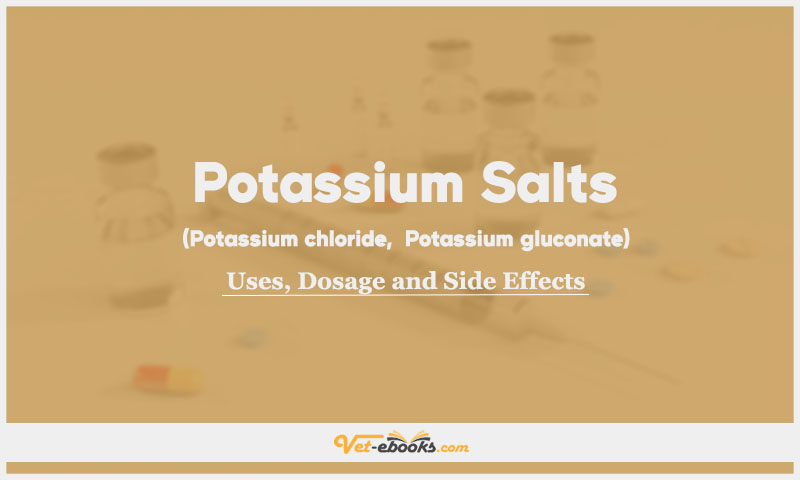Potassium salts (Potassium chloride,
Potassium gluconate) In Dogs & Cats: Uses, Dosage and Side Effects

Contents hide
Overview
- Replacement of potassium.
Uses of Potassium salts (Potassium chloride,
Potassium gluconate)
- Treatment or prevention of known hypokalaemic states; prolonged anorexia and chronic renal failure are the most common, but can also be used with diuretics that are not potassium-sparing.
Dose of Potassium salts (Potassium chloride,
Potassium gluconate) in Dogs and Cats
Dogs:
Correction of hypokalaemia:
- Intravenous doses
- Must be titrated for each patient; dilute concentrated solutions before use (normally 20–60 mmol/l).
- Rate of i.v. infusion should not exceed 0.5 mmol/kg/h, especially when the concentration in replacement fluid is >60 mmol/l.
- The use of fluid pumps is recommended.
2- Oral:
- The replacement dose needs to be titrated to maintain mid-range normal values in each patient. Starting doses are 2 mEq per 4.5 kg in food q12h or 2.2 mEq per
100 kcal required energy intake.
Cats:
Correction of hypokalaemia:
- Intravenous doses as for dogs.
- Oral: The replacement dose needs to be titrated to maintain mid-range normal values in each patient. Starting doses are 2.2 mEq per 4.5 kg in food q12h or 2–6 mEq/
cat/day p.o. in divided doses q8–12h.
Drug Dosage Calculator
You Should Give:
Side Effects of Potassium salts (Potassium chloride,
Potassium gluconate) in Dogs and Cats
- Hyperkalemia primarily develops when the administration of potassium occurs too quickly or in patients with impaired kidney function.
- Clinical symptoms of hyperkalemia include a spectrum of effects, such as muscle weakness, gastrointestinal disturbances, cardiac arrhythmias, and even cardiac arrest.
- Potassium concentrations exceeding 60 mmol/l may result in pain, peripheral vein sclerosis, and an elevated risk of overdose.
Contraindications of Potassium salts (Potassium chloride, Potassium gluconate) in Dogs and Cats
- Hyperkalaemia
- Acute or obstructive renal failure
- Untreated Addison’s disease
- Acute dehydration and diseases with impaired or obstructed GI motility
Some Notes:
- Potassium retention leads to severe hyperkalaemia may develop when used with angiotensin-converting enzyme inhibitors (e.g. captopril, enalapril) or potassium-sparing
diuretics (e.g. spironolactone). - Potassium chloride is not compatible with many drugs especially those in sodium salt form.
- When rapid correction is not required, potassium can be added to subcutaneous (s.c.) fluids, but the concentration should not exceed 30 mEq/l due to potential irritation.
- It’s important to note that potassium is mainly found inside cells, so serum concentrations may not immediately reflect its clinical effects.
- Avoid administering rapid intravenous (i.v.) injections, and concentrated potassium solutions must be diluted before i.v. use.
- Exercise caution when using potassium in patients with renal failure, as approximately 80-90% of potassium excretion relies on the kidneys.
- Additionally, be cautious when using potassium in patients who are on digitalis medications.
Tip
Do You Want To Increase Your Veterinary Knowledge and Practical Skills?
You Can Now Browse and Download +3000 Books For Veterinary Professionals & Students Online.
Download Veterinary Books



















